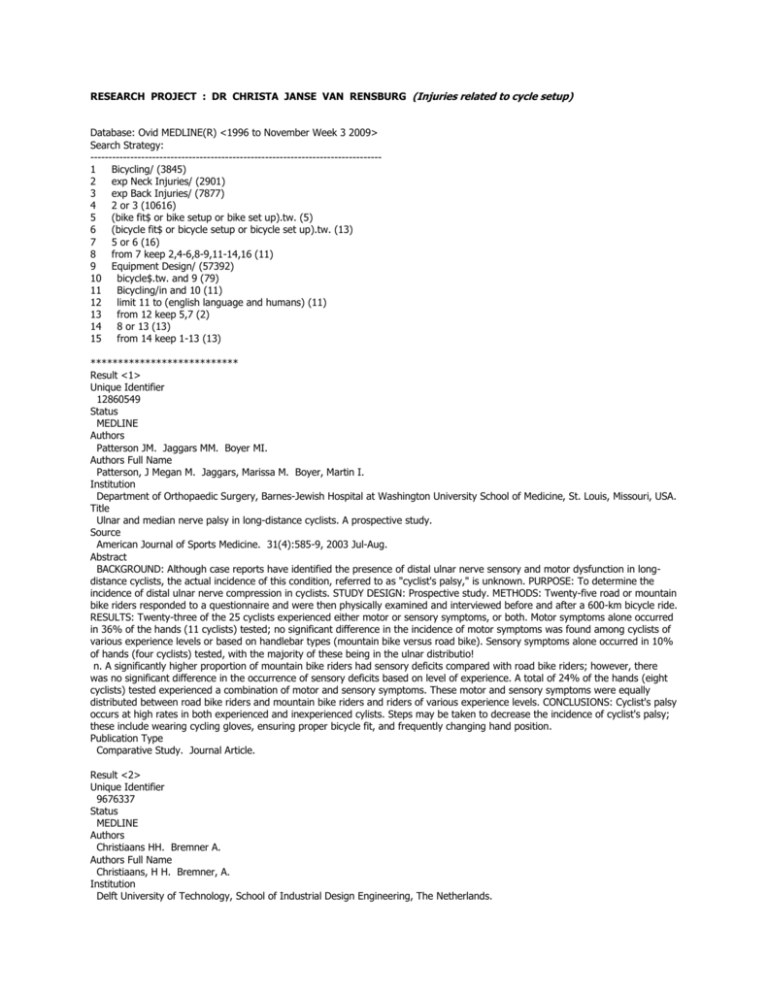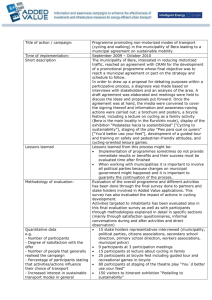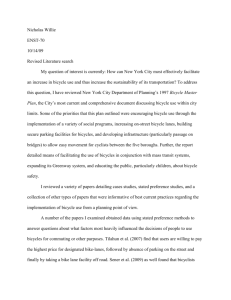setup - Department of Library Services
advertisement

RESEARCH PROJECT : DR CHRISTA JANSE VAN RENSBURG (Injuries related to cycle setup) Database: Ovid MEDLINE(R) <1996 to November Week 3 2009> Search Strategy: -------------------------------------------------------------------------------1 Bicycling/ (3845) 2 exp Neck Injuries/ (2901) 3 exp Back Injuries/ (7877) 4 2 or 3 (10616) 5 (bike fit$ or bike setup or bike set up).tw. (5) 6 (bicycle fit$ or bicycle setup or bicycle set up).tw. (13) 7 5 or 6 (16) 8 from 7 keep 2,4-6,8-9,11-14,16 (11) 9 Equipment Design/ (57392) 10 bicycle$.tw. and 9 (79) 11 Bicycling/in and 10 (11) 12 limit 11 to (english language and humans) (11) 13 from 12 keep 5,7 (2) 14 8 or 13 (13) 15 from 14 keep 1-13 (13) *************************** Result <1> Unique Identifier 12860549 Status MEDLINE Authors Patterson JM. Jaggars MM. Boyer MI. Authors Full Name Patterson, J Megan M. Jaggars, Marissa M. Boyer, Martin I. Institution Department of Orthopaedic Surgery, Barnes-Jewish Hospital at Washington University School of Medicine, St. Louis, Missouri, USA. Title Ulnar and median nerve palsy in long-distance cyclists. A prospective study. Source American Journal of Sports Medicine. 31(4):585-9, 2003 Jul-Aug. Abstract BACKGROUND: Although case reports have identified the presence of distal ulnar nerve sensory and motor dysfunction in longdistance cyclists, the actual incidence of this condition, referred to as "cyclist's palsy," is unknown. PURPOSE: To determine the incidence of distal ulnar nerve compression in cyclists. STUDY DESIGN: Prospective study. METHODS: Twenty-five road or mountain bike riders responded to a questionnaire and were then physically examined and interviewed before and after a 600-km bicycle ride. RESULTS: Twenty-three of the 25 cyclists experienced either motor or sensory symptoms, or both. Motor symptoms alone occurred in 36% of the hands (11 cyclists) tested; no significant difference in the incidence of motor symptoms was found among cyclists of various experience levels or based on handlebar types (mountain bike versus road bike). Sensory symptoms alone occurred in 10% of hands (four cyclists) tested, with the majority of these being in the ulnar distributio! n. A significantly higher proportion of mountain bike riders had sensory deficits compared with road bike riders; however, there was no significant difference in the occurrence of sensory deficits based on level of experience. A total of 24% of the hands (eight cyclists) tested experienced a combination of motor and sensory symptoms. These motor and sensory symptoms were equally distributed between road bike riders and mountain bike riders and riders of various experience levels. CONCLUSIONS: Cyclist's palsy occurs at high rates in both experienced and inexperienced cylists. Steps may be taken to decrease the incidence of cyclist's palsy; these include wearing cycling gloves, ensuring proper bicycle fit, and frequently changing hand position. Publication Type Comparative Study. Journal Article. Result <2> Unique Identifier 9676337 Status MEDLINE Authors Christiaans HH. Bremner A. Authors Full Name Christiaans, H H. Bremner, A. Institution Delft University of Technology, School of Industrial Design Engineering, The Netherlands. Title Comfort on bicycles and the validity of a commercial bicycle fitting system. Source Applied Ergonomics. 29(3):201-11, 1998. Abstract Research has been undertaken into the question of comfort on a standard 'utility' bicycle. Most ergonomics studies on bicycles so far have focused on biomechanical and physiological factors influencing the efficiency of road racing. The actual use of a utility bicycle has been neglected in this research. One of the reasons, especially in studying sitting comfort on bicycles, is that conclusions must be based on subjective measurements. In the study described in this paper, the main focus is on the measurement of cyclists' preferences in a dynamic way, compared to physical data. A pilot study and laboratory experiment were carried out to investigate, among other aspects of cycling comfort, the validity of existing rules of thumb for bicycle fitting. The data, collected with the aid of two specially designed ergonomics measuring stations and an 'interactive remote-control bicycle simulator', indicate that these rules of thumb are questionable. By way of improving the fit bet! ween cyclist and machine (and assisting bicycle shopkeepers to select the right bicycle for their customers), a commercial bicycle fitting system has been proposed and developed for production. Publication Type Journal Article. Result <3> Unique Identifier 8664843 Status MEDLINE Authors Sheel AW. Lama I. Potvin P. Coutts KD. McKenzie DC. Authors Full Name Sheel, A W. Lama, I. Potvin, P. Coutts, K D. McKenzie, D C. Institution Allan McGavin Sports Medicine Centre, Vancouver, BC. Title Comparison of aero-bars versus traditional cycling postures on physiological parameters during submaximal cycling. Source Canadian Journal of Applied Physiology. 21(1):16-22, 1996 Feb. Abstract The purpose of this investigation was to quantify the difference in energy expenditure between traditional cycling handlebars and aero-bars during outdoor submaximal cycling. Eleven trained cyclists (age = 29.3 +/- 1.9 years, weight = 69.4 +/- 3.8 kg, VO2max = 58.1 +/- 2.0 ml.kg-1.min-1) were randomly assigned a sequence of three hand positions: brake hoods (BH), drop-bars (DB), and aero-bars (AB). Subjects cycled at 30 km.h-1 in one position for 5 minutes, then recovered until HR fell below 120 bpm. This was then repeated for the other hand positions. All cycling was completed on a standard racing bike fitted with aero-bars. Tire pressure was held constant for all trials. A portable telemetric system (Cosmed K-2) was used to measure VO2, VE and heart rate (HR) during the trials. No statistical differences were observed between AB and DB. Significant differences (p < .05) were found between BH (VE = 66.1 +/- 2.7 L.min-1; HR = 152 +/- 4 bpm; VO2 = 1.56 +/- .15 L.min-1) and ! AB (VE = 61.3 +/- 2.8 L.min-1; HR = 146 +/- 4 bpm; VO2 = 1.31 +/- .10 L.min-1). AB provides an energy savings over the traditional BH cycling posture. Publication Type Clinical Trial. Comparative Study. Journal Article. Randomized Controlled Trial. Result <4> Unique Identifier 16003043 Status MEDLINE Authors Silberman MR. Webner D. Collina S. Shiple BJ. Authors Full Name Silberman, Marc R. Webner, David. Collina, Steven. Shiple, Brian J. Institution New Jersey Sports Medicine and Performance Center LLC, Gillette, NJ 07933, USA. drbicycle@njsportsmed.com Title Road bicycle fit. Source Clinical Journal of Sport Medicine. 15(4):271-6, 2005 Jul. Publication Type Journal Article. Result <5> Unique Identifier 17883970 Status MEDLINE Authors Asplund C. Barkdull T. Weiss BD. Authors Full Name Asplund, Chad. Barkdull, Thad. Weiss, Barry D. Institution Family Medicine Residency Program, Dwight D. Eisenhower Army Medical Center, 300 East Hospital Road, Augusta, GA 30905, USA. chad.asplund@us.army.mil Title Genitourinary problems in bicyclists. [Review] [41 refs] Source Current Sports Medicine Reports. 6(5):333-9, 2007 Oct. Abstract Genitourinary complaints are common in cyclists. Bicycle fit, improper saddle type, and individual anatomic factors are important evaluation criteria to consider when diagnosing symptoms and determining treatment options. By learning how to recognize and treat contributing factors, as well as learning a few simple bike-fitting techniques, physicians can treat and prevent many common problems associated with bicycling. [References: 41] Publication Type Journal Article. Review. Result <6> Unique Identifier 16144585 Status MEDLINE Authors Asplund C. Webb C. Barkdull T. Authors Full Name Asplund, Chad. Webb, Charles. Barkdull, Thad. Institution Eisenhower Army Medical Center, Fort Gordon, GA 30905-5650, USA. chad.asplund@us.army.mil Title Neck and back pain in bicycling. Source Current Sports Medicine Reports. 4(5):271-4, 2005 Oct. Abstract Neck and back pain are among the most common overuse injuries in cyclists. Bicycle fit, improper equipment, training errors, and individual anatomic factors are important evaluation considerations. By learning how to recognize and treat contributing factors, as well as learning a few simple bike-fitting techniques, physicians can treat and prevent many common problems of this popular activity. Publication Type Journal Article. Result <7> Unique Identifier 19427244 Status MEDLINE Authors Lim CS. Gohel MS. Shepherd AC. Davies AH. Authors Full Name Lim, C S. Gohel, M S. Shepherd, A C. Davies, A H. Institution Imperial Vascular Unit, 4 North, Charing Cross Hospital, Imperial College, London W6 8RF, United Kingdom. cslim@doctors.org.uk Title Iliac artery compression in cyclists: mechanisms, diagnosis and treatment.[see comment]. [Review] [58 refs] Comments Comment in: Eur J Vasc Endovasc Surg. 2009 Aug;38(2):187; PMID: 19482492 Source European Journal of Vascular & Endovascular Surgery. 38(2):180-6, 2009 Aug. Abstract OBJECTIVES: To review the mechanisms, diagnosis and treatment options for symptomatic iliac artery compression in cyclists. METHODS: Pubmed, Medline, Embase and Google were searched using combinations of the terms 'iliac artery disease', 'iliac artery compression', 'iliac artery stenosis', 'cyclists' and 'athletes'. RESULTS: Tethering of the iliac artery by the psoas arterial branch and fibrous tissue, and muscular hypertrophy predispose the vessel to kinking and compression during cycling. Symptoms may only be present on maximal exercise in the cycling position. Provocative exercise tests using a cycling ergometer with ankle brachial pressure index measuring has a sensitivity of 85% to detect arterial insufficiency. Magnetic resonance imaging is increasingly being used as the investigation of choice to confirm the diagnosis, although digital subtraction angiography and colour duplex ultrasonography may also help. Conservative measures including adjustments to the cycling ! posture and bicycle setup should be recommended to all patients. The evidence for surgical and endovascular treatments is limited and the use of prosthetic graft should be avoided. CONCLUSIONS: Iliac artery compression should be recognised as an important differential diagnosis in competitive cyclist presenting with lower limb symptoms. Although the optimal treatment strategy remains unclear, early diagnosis may reduce unnecessary investigations, and enable the cyclist to make appropriate adjustments and decisions in treatment management. [References: 58] Publication Type Journal Article. Review. Result <8> Unique Identifier 10073627 Status MEDLINE Authors Green BN. Johnson CD. Maloney A. Authors Full Name Green, B N. Johnson, C D. Maloney, A. Institution Palmer Center for Chiropractic Research, Palmer College of Chiropractic West, San Jose, California 94580, USA. Title Effects of altering cycling technique on gluteus medius syndrome. Source Journal of Manipulative & Physiological Therapeutics. 22(2):108-13, 1999 Feb. Abstract OBJECTIVE: We discuss how altering the cycling technique of a cyclist receiving periodic chiropractic care helped in the management of gluteus medius syndrome. CLINICAL FEATURES: A 24-year-old male amateur cyclist had numbness and tingling localized to a small region on the superior portion of the right buttock. The area involved demonstrated paresthesia to light touch sensory evaluation. The cyclist had received chiropractic adjustments 2 days before the onset of the symptoms. One week earlier, the patient began riding a new bicycle with different gearing than his previous one. Manual-resisted muscle testing created soreness in the lumbosacral area and buttocks. Trigger points were identified in the right gluteus medius. Standing lumbar spine flexion was 70 degrees, limited by tight hamstrings. INTERVENTION AND OUTCOME: Because the patient was already receiving periodic chiropractic care, no passive therapy was used. Patient education regarding the difference in gear sele! ction in bicycles of a higher quality was provided. He was instructed to train in lower gears than he had previously used and to maintain a cadence of 70 to 90 revolutions of the pedals per minute. After 2 days, the paresthesia on the right buttock resolved. The trigger points were only mildly tender with minimal residual soreness of the involved muscles. CONCLUSION: Management of gluteus medius syndrome by altering the cadence and gear development for a bicyclist is discussed. Either frank or cumulative injury to the gluteus medius muscle is the typical etiologic factor for this syndrome. Repetitive strain of the patient's gluteus medius muscle as a result of poor cycling technique appeared to be the cause here. Knowledge of bicycle fitting, training techniques, and bicycle mechanics appeared necessary to resolve the problem. Publication Type Case Reports. Journal Article. Research Support, Non-U.S. Gov't. Result <9> Unique Identifier 18063715 Status MEDLINE Authors Wanich T. Hodgkins C. Columbier JA. Muraski E. Kennedy JG. Authors Full Name Wanich, Tony. Hodgkins, Christopher. Columbier, Jean-Allain. Muraski, Erika. Kennedy, John G. Institution Department of Orthopaedic Surgery, Hospital for Special Surgery, New York, NY 10021, USA. Title Cycling injuries of the lower extremity. [Review] [32 refs] Source Journal of the American Academy of Orthopaedic Surgeons. 15(12):748-56, 2007 Dec. Abstract Cycling is an increasingly popular recreational and competitive activity, and cycling-related injuries are becoming more common. Many common cycling injuries of the lower extremity are preventable. These include knee pain, patellar quadriceps tendinitis, iliotibial band syndrome, hip pain, medial tibial stress syndrome, stress fracture, compartment syndrome, numbness of the foot, and metatarsalgia. Injury is caused by a combination of inadequate preparation, inappropriate equipment, poor technique, and overuse. Nonsurgical management may include rest, nonsteroidal anti-inflammatory drugs, corticosteroid injection, ice, a reduction in training intensity, orthotics, night splints, and physical therapy. Injury prevention should be the focus, with particular attention to bicycle fit and alignment, appropriate equipment, proper rider position and pedaling mechanics, and appropriate training. [References: 32] Publication Type Journal Article. Review. Result <10> Unique Identifier 18046192 Status MEDLINE Authors Sauer JL. Potter JJ. Weisshaar CL. Ploeg HL. Thelen DG. Authors Full Name Sauer, Julie L. Potter, James J. Weisshaar, Christine L. Ploeg, Heidi-Lynn. Thelen, Darryl G. Institution Department of Biomedical Engineering, University of Wisconsin-Madison, Madison, WI 53706, USA. Title Biodynamics. Influence of gender, power, and hand position on pelvic motion during seated cycling. Source Medicine & Science in Sports & Exercise. 39(12):2204-11, 2007 Dec. Abstract INTRODUCTION/PURPOSE: An understanding of normal pelvic motion during seated cycling is relevant to saddle design and bicycle fitting. In this study, we investigated the effects of gender, power, and hand position on pelvic motion throughout a pedal stroke. We also investigated whether anthropometric factors could explain any interindividual differences observed. METHODS: Twelve experienced male and 14 experienced female cyclists participated. Each subject was custom fitted to a stationary bicycle and then rode the bicycle at three power outputs (100, 150, and 200 W), with their hands in the tops and drops position. The kinematics of a triad of motion-capture markers, located on posterior pelvic landmarks, were used to characterize pelvic motion. RESULTS: The largest angular excursions were observed in the nonsagittal planes, with the pelvis rotating internally (approximately 3 degrees ) and rolling laterally ( approximately 2 degrees ) toward the downstroke. These pelvic ! rotations caused the hip on the downstroke side to translate anteriorly and inferiorly. Compared with males, females exhibited greater average anterior pelvic tilt in the drops hand position (males: 21 +/- 3 degrees ; females: 24 +/- 4 degrees ; P = 0.036). Interindividual differences in pelvic motion could not be independently explained by measures of ischial tuberosity width or hamstring flexibility. However, average anterior pelvic tilt was negatively correlated with lumbar flexibility among the males (r = 0.75; P = 0.024), suggesting that this may be an important factor to consider in bicycle fitting. CONCLUSIONS: We observed substantial pelvic motion during seated cycling, with experienced female road cyclists exhibiting greater average anterior tilt than their male counterparts. Pelvic motion seems to arise naturally during seated cycling and should be considered when designing saddles and establishing bicycle-fitting procedures. Publication Type Journal Article. Result <11> Unique Identifier 10081053 Status MEDLINE Authors Conti-Wyneken AR. Authors Full Name Conti-Wyneken, A R. Institution Department of Physical Medicine and Rehabilitation, Roudebush Veterans Affairs Medical Center, Indianapolis, Indiana, USA. Title Bicycling injuries. [Review] [16 refs] Source Physical Medicine & Rehabilitation Clinics of North America. 10(1):67-76, 1999 Feb. Abstract The severity of injuries secondary to bicycling range from the pain and nuisance of skin abrasions to life-threatening brain injuries. For most injuries, the key to treatment and prevention is careful assessment of bike fit and training techniques. In general, the treatment of musculoskeletal and neuropathic lesions should follow sound, physiatric treatment principles. Clearly, all clinicians who treat bicyclists have a professional responsibility to educate them on the use of helmets and safe riding rules. [References: 16] Publication Type Journal Article. Review. Result <12> Unique Identifier 12561398 Status MEDLINE Authors Bornman J. Authors Full Name Bornman, Johan. Title Novel bicycle saddle--readers taken for a ride?[comment]. Comments Comment on: S Afr Med J. 2002 Apr;92(4):295-8; PMID: 12056361 Source South African Medical Journal. Suid-Afrikaanse Tydskrif Vir Geneeskunde. 92(12):928-9; author reply 929-30, 2002 Dec. Publication Type Comment. Letter. Result <13> Unique Identifier 12056361 Status MEDLINE Authors Keytel LR. Noakes TD. Authors Full Name Keytel, L R. Noakes, T D. Institution Department of Human Biology, University of Cape Town Medical School, Sports Science Institute of South Africa. Title Effects of a novel bicycle saddle on symptoms and comfort in cyclists.[see comment]. Comments Comment in: S Afr Med J. 2002 Dec;92(12):928-9; author reply 929-30; PMID: 12561398 Source South African Medical Journal. Suid-Afrikaanse Tydskrif Vir Geneeskunde. 92(4):295-8, 2002 Apr. Abstract BACKGROUND: While the bicycle frame and other parts of the bicycle have undergone many improvements, the bicycle saddle has remained relatively unchanged since it was first designed more than 100 years ago. Given the number and range of cycling injuries believed to result from the saddle, this is surprising. This study investigated the effects of a novel bicycle saddle on saddle-related comfort and symptoms during cycling. METHOD: Eleven competitive or recreational cyclists, 6 females and 5 males, performed three 2-hour stationary cycle rides in the laboratory, using their personal bicycles. Ride 1 was performed using the standard bicycle saddle and rides 2 and 3 using the novel bicycle saddle. Subjects reported saddle comfort rating scores (SC) while using the different saddles. Subjects also completed a questionnaire evaluating saddle symptoms (SS) when using either the conventional or the novel bicycle saddle during daily cycling. RESULTS: The most common saddle-related! medical complaint with chronic use of the conventional saddle was painful pubic bones, with or without chaffing. Others were severe chaffing, saddle sores, chaffing and back pain, and painful pubic bones associated with a loss of feeling in the pelvic area. The mean SS rating score during the 2-hour laboratory ride was significantly less for the novel saddle (11.6 +/- 1.2 versus 19.1 +/3.2 arbitrary units, P < 0.01). Similarly the mean SC score was significantly lower for the novel saddle (36.2 +/- 10.5 v. 54.7 +/11.2 arbitrary units). Values for both SC scores were similar for rides 2 and 3. On completion of the trial all subjects indicated that they would continue to use the novel saddle in preference to the conventional saddle. Three months later 9 subjects (82%) reported continued use of this saddle in preference to the conventional saddle. CONCLUSION: These results show conclusively that this novel bicycle saddle: (i) significantly reduced reported symptoms during! daily cycling compared with the conventionally designed cycling saddl e; (ii) significantly improved saddle comfort during 2-hour cycles in the laboratory, such that (iii) when given the option the majority (82%) of the subjects chose to use this saddle 3 months later. Furthermore, the beneficial effects of the novel saddle were apparent during its first use, suggesting that the novel saddle is effective because the design is anatomically correct. Publication Type Clinical Trial. Journal Article. Research Support, Non-U.S. Gov't.





